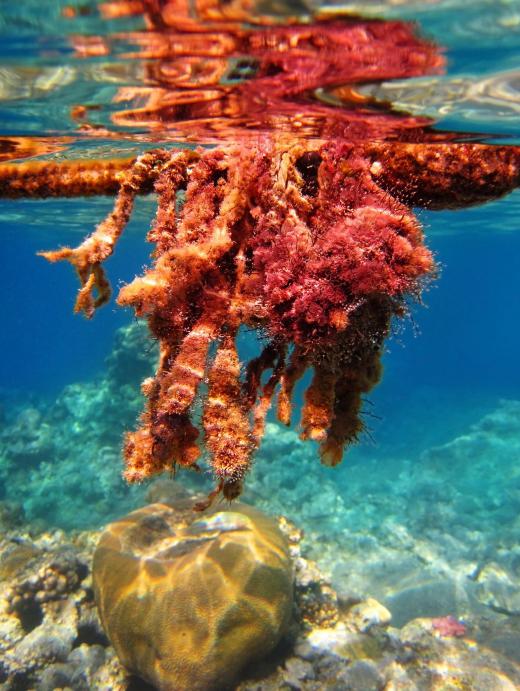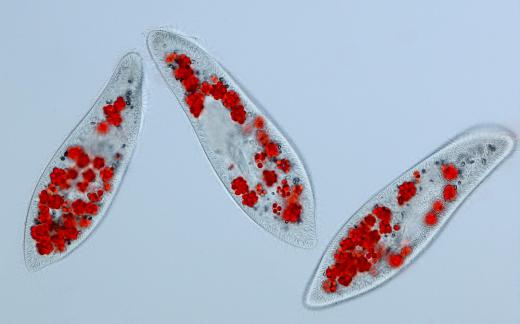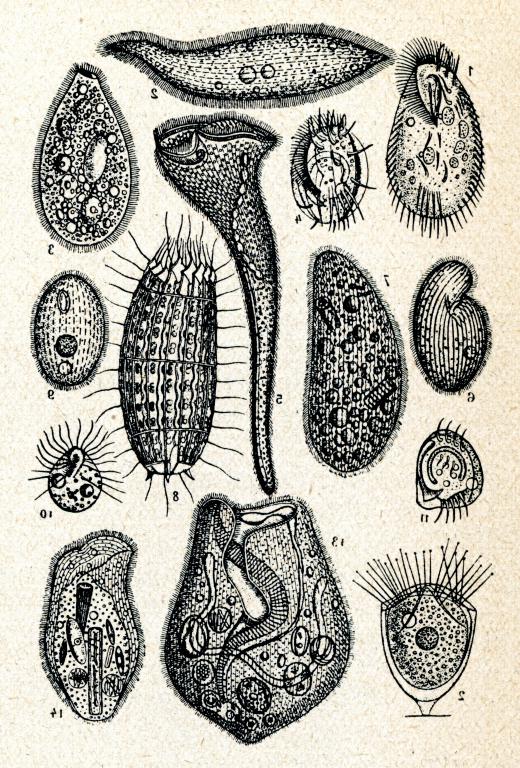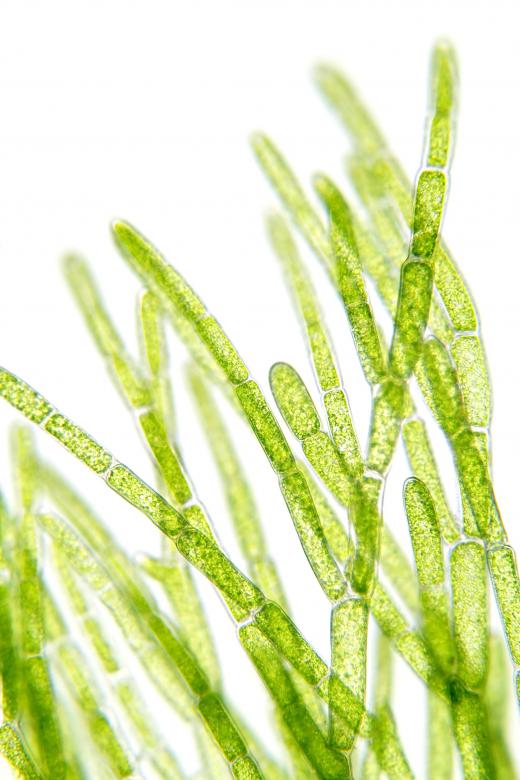What are Protists?
 Michael Anissimov
Michael Anissimov
Protists is a catch-all term used to describe all eukaryotic organisms — meaning those that have cells with nuclei — besides animals, plants, and fungi. Examples include the unicellular animal-like protozoa, the fungus-like slime molds, and the plant-like protophyta. These organisms were formerly regarded as belonging to a kingdom in their own right, like plants and animals, but it is now known, through analysis of DNA, that many of them are not closely related to one another, and that some may be closer to organisms within other kingdoms than to their fellow protists. The term derives from the Greek protiston, meaning the "first of all ones." These organisms are often microscopic, and are either unicellular or an undifferentiated multicellular mass.
Classification

Superficial resemblances and differences between protists can be misleading. As more analysis has been carried out at the molecular level, surprising relationships have emerged. For example, the kelp seaweed that can reach 164 feet (50 meters) in length turns out to be more closely related to microscopic diatoms than to some other seaweeds, while green algae are more closely related to members of the plant kingdom than to other apparently similar protists such as red algae. It is generally recognized that some kind of re-classification among this category of life forms is required; this may result in them being split into several kingdoms, or in some types being grouped with other kingdoms. The classification of protists is still an area of ongoing research, and may be subject to further revisions as more information emerges, but, on a slightly less scientific basis, these organisms can be roughly grouped into the animal-like, the plant-like, and the less numerous fungus-like types.
Animal-Like Forms

These types are all single-celled, and are often capable of independent motion. Most either actively hunt for food or are parasites that infect other organisms, although a few generate their own food by photosynthesis. They include the life forms generally known as protozoa, as well as numerous other organisms.
Those that are capable of locomotion use one of three methods. Ciliates, such as the well-known paramecium, use tiny moving hairs known as cilia to travel through water. Flagellates use a long whip-like structure called a flagellum to propel themselves, while amoeba-like forms have a soft, flexible cell membrane, and are able to move over surfaces by flowing along, producing pseudopods — foot-like projections. Some types can switch between a flagellate and an amoeba-like form, while some parasitic forms, such as plasmodium, which causes malaria, and toxoplasma, which causes toxoplasmosis, are incapable of independent movement and often have complex life cycles involving more than one host.

Another interesting group is the dinoflagellates. These mobile marine and freshwater organisms propel themselves using flagellae, but, like plants and algae, many create their own food by photosynthesis. Some types display bioluminescence, and if present in large numbers they can produce a visible glow in seawater at night. Other types produce powerful toxins, and are responsible for the “red tide” that can kill fish and other organisms — the red color comes from the photosynthetic pigment they use.
Plant-Like Forms

This group consists of mostly non-mobile photosynthetic organisms. The red and green algae are perhaps the best-known types, although the category includes some very different looking life forms. They range from microscopic single celled organisms to very large multicellular forms, such as seaweeds.
Red algae take their name from a red pigment called phycoerythrin that performs the same photosynthetic function as chlorophyll in green algae and plants, but absorbs blue light. This allows them to live at greater depths than green algae, as light in the blue range of the spectrum penetrates water more deeply. Red algae include a number of types of seaweed, some of which are edible. Certain types produce a calcium carbonate crust around themselves, and are important in the formation of reefs in some areas.

Green algae resemble members of the plant kingdom in that they use the same forms of chlorophyll. They are, in fact, thought to be the ancestors of green plants. They vary from single celled to multicellular types, and can be found in a variety of aquatic or moist environments. Some species are marine and include many seaweeds, while others are found in freshwater, or in damp, shady places. A number of types have formed a symbiotic relationship with certain fungi, in the form of lichens.
The chromista are an extremely varied group of plant-like protists. They include the huge kelp seaweeds that can form great forests on the ocean floor, as well as the diatoms, which are microscopic, single-celled organisms that encase themselves in silica coatings, often with very intricate and beautiful structures. Diatoms occur in fresh water, and in the sea, where they are an important part of the phytoplankton that forms the base of the marine food chain.
Fungus-Like Forms
These consist of various types of slime mold; however, although they resemble fungi in their outward appearance, and were once classed as such, they are in fact completely unrelated. They consist of mobile, single celled organisms that move around in colonies, feeding on microorganisms, such as bacteria. The cells can merge together at a certain stage, sometimes forming what is, in effect, one huge cell with many nuclei. They can reproduce by forming structures containing spores, which are released to form new slime molds when they land in a favorable environment. Slime molds can be found on soil, tree bark, and decaying organic matter, such as rotting wood.
AS FEATURED ON:
AS FEATURED ON:















Discussion Comments
Anyone know what a main color for a protist is?
@anon131227 - There's nothing wrong with protists in general. In fact, without them, we'd have no earth as we know it, since algae are protists and they are the bottom line of quite a few ecosystems. Without algae to eat, we wouldn't have a lot of ocean species for example. And humans eat algae as well, since it's very nutritious.
There are many varied examples of protists, they aren't just one type of creature. There are some "bad" ones, the like kind that causes potato blight, or the one that causes malaria, but in general they are a necessary part of the world.
@anon20754 - They are completely different from bacteria in their organization and their activity. For one thing, they are often much larger than bacteria. They have membrane enclosed DNA, like we do, while bacteria have DNA in one long strand in their bodies.
There are other physical differences but I can't remember them all. If you look up some protists pictures and diagrams and compare them to bacteria I'm sure you'd see the differences.
One thing to remember is that protists can cause illness just like bacteria can. Malaria, for example, is caused by a protist, not a bacterium.
@anon13745 - They are roughly grouped into protozoa (animal-like protists) and protophyta (plant-like protists). But scientists don't really like using these classifications now, since they have been replaced by much more accurate ones based on the characteristics of the protists, rather than on their similarity to either plants or animals (which they may not be related to, after all).
what's another name for pseudopods?
Is watermelon snow a plant-like protista or a fungus-like protista?
what is the problem with protists? what do they do that is very bad to your body or any other organism!
the finger like projections for capturing prey, like in amoeba, are called pseudopods or pseudopodia.
The finger like projections that some protists use for capturing prey are called what?
What are some of the differences between protists and bacteria?
What is another name for animal-like protists, and plant-like protists?
Post your comments